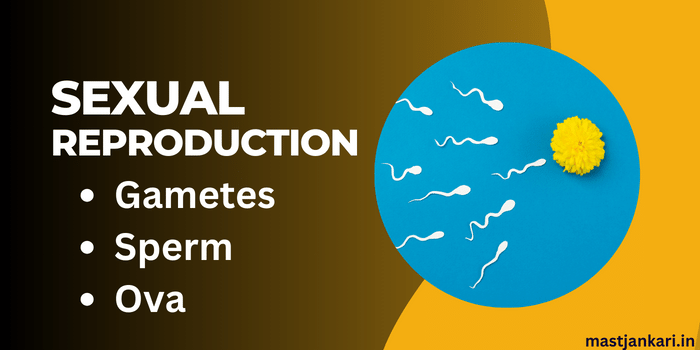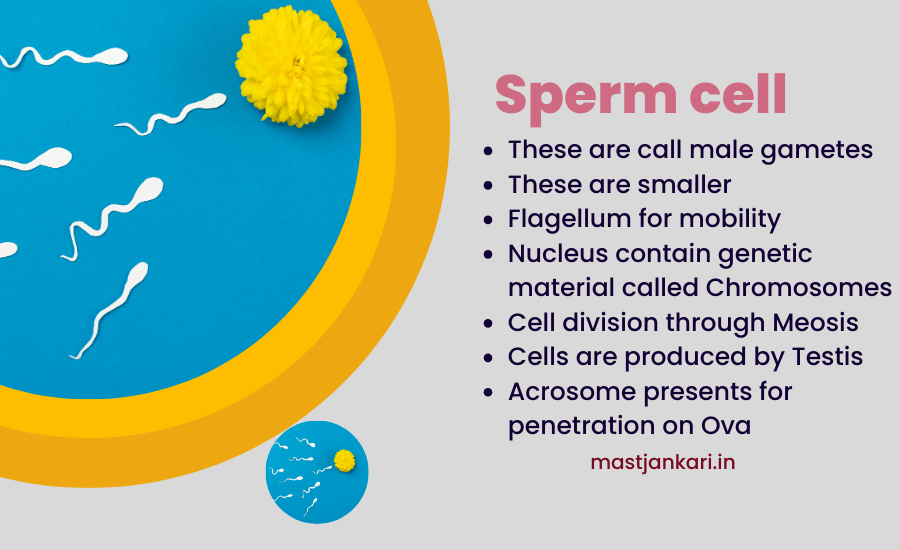Definition of Sexual Reproduction:
Sexual reproduction is a biological process by which offspring are produced. This process involves the fusion of specialized reproductive cells or we can say The cell involved in sexual reproduction are known as gametes.
Sexual reproduction is a fundamental aspect of the life cycle of many organisms, including plants, animals, and fungi, where in asexual reproduction offspring are produced from a single parent without the involvement of gametes or the fusion of genetic material.
The cell involved in sexual reproduction are called Gametes
Gametes are of two types:
- Male gamete: also known as Sperm
- Female Gamete: also known as Egg or Ova

Significance of Cells in Sexual Reproduction:
The cells involved in sexual reproduction, are known as gametes and somatic cells, play a important role in the continuity of life and these are also responsible for the generation of biological diversity. The significance of cells in sexual reproduction can be understood in several key aspects
- Genetic Variation: Sexual reproduction introduces genetic diversity by combining genetic material from two parents. This diversity is essential for the adaptation and evolution of populations over time.
- Specialization and Differentiation: Cells undergo specialized roles in the reproductive process. Gametes, such as sperm and egg cells, are specialized for the purpose of fertilization. Somatic cells support the reproductive process by forming the tissues and organs necessary for the development of the organism.
- Adaptation to Environmental Changes: The genetic diversity resulting from sexual reproduction allows populations to better adapt to changes in the environment. This adaptability is crucial for the survival and success of a species in varying ecological conditions.
- Repair and Maintenance: Somatic cells are involved in the repair and maintenance of the organism’s body. They ensure the proper functioning and integrity of tissues and organs, contributing to the overall health and longevity of the individual.
cells involved in sexual reproduction promote genetic diversity.
Cells Involved in sexual reproduction:

A. Gametes:
Definition and Characteristics:
Definition: Gametes are specialized reproductive cells that are involved in sexual reproduction. These cells are haploid, meaning they carry only one set of chromosomes, which is half the number found in the somatic cells of the organism.
Characteristics: Gametes exhibit several key characteristics:
- Haploid Nature: Gametes carry one set of chromosomes (n) as opposed to the diploid state (2n) found in most other cells of the organism.
- Specialized Structure: Gametes often have a distinct structure that facilitates their role in sexual reproduction. For example, sperm cells (male gametes) are typically streamlined with a tail for mobility, while egg cells (female gametes) may contain nutrient-rich cytoplasm to support early embryonic development.
- Formation through Meiosis: Gametes are produced through a specialized cell division process called meiosis. Meiosis ensures that each gamete receives a unique combination of genetic material from the parent organism.
gametes are specialized reproductive cells
Role in Sexual Reproduction:
- Fusion for Genetic Diversity: The primary role of gametes in sexual reproduction is to fuse during fertilization, forming a zygote. This fusion combines genetic material from two parent organisms, resulting in a new individual with a unique combination of genes. This process introduces genetic diversity within a population, which is essential for the adaptation and evolution of a species over time.
- Contribution to Offspring: The zygote formed by the fusion of gametes undergoes development to eventually give rise to a new organism. The genetic information carried by the gametes determines various traits and characteristics of the offspring.
- Ensuring Chromosomal Stability: The haploid nature of gametes is crucial in maintaining the chromosomal stability of a species. When gametes fuse, the resulting diploid zygote restores the normal chromosomal number for the species.
B. Somatic Cells:
Definition and Characteristics:
Definition: Somatic cells are the non-reproductive cells of an organism, constituting the majority of its body cells. These cells are diploid, meaning they have two sets of chromosomes (2n), with one set inherited from each parent.
Characteristics: Somatic cells have the following key characteristics:
- Diploid Nature: Unlike gametes, somatic cells are diploid and contain the full complement of chromosomes typical for the species.
- Varied Functions: Somatic cells are highly diverse and perform a wide range of functions depending on their specialization. For example, somatic cells can be muscle cells, nerve cells, skin cells, and more.
- Mitotic Division: Somatic cells undergo mitosis, a type of cell division that results in two daughter cells, each identical to the parent cell. This process is responsible for growth, repair, and maintenance of the organism’s body.

Differentiation from Gametes:
- Chromosome Number: The most fundamental difference between somatic cells and gametes is the chromosome number. Somatic cells are diploid, containing two sets of chromosomes (2n), while gametes are haploid, containing only one set of chromosomes (n).
- Function and Structure: Somatic cells are differentiated to perform specific functions in the body, such as carrying out nerve impulses (neurons) or contracting (muscle cells). In contrast, gametes are specialized for reproduction and have a distinct structure to facilitate their role in fertilization.
Supporting Role in Sexual Reproduction:
- Tissue and Organ Formation: Somatic cells play a crucial role in the formation of tissues and organs necessary for sexual reproduction. For instance, cells in the reproductive organs, like the testes and ovaries, are somatic cells that contribute to the development of gametes.
- Nurturing the Zygote: After fertilization, the zygote undergoes multiple cell divisions, with somatic cells forming various tissues and structures in the developing organism. Somatic cells continue to support the growing organism by maintaining and repairing tissues throughout its life.
- Hormonal Regulation: Somatic cells, particularly those in endocrine glands, contribute to the production of hormones that regulate reproductive processes, influencing the development and functioning of the reproductive system.
The fusion product of sperm and ovum is known as a zygote.
Gametes Involved in sexual reproduction:
Male Gametes: Sperm Cells
Characteristics and Function:
- Microscopic Structure: Sperm cells, also known as spermatozoa, are the male reproductive cells. They are small, streamlined cells with a distinctive microscopic structure.
- Flagellum for Mobility: Sperm cells have a long, whip-like tail called the flagellum, which propels them forward, enabling them to swim towards the egg for fertilization.
- Acrosome for Penetration: The head of the sperm contains an acrosome, a cap-like structure that houses enzymes. This acrosome is crucial for penetrating the protective layers of the egg during fertilization.
Production and Maturation:
- Location of Production: Sperm cells are produced in the testes through a process called spermatogenesis, which involves the continuous division and differentiation of germ cells.
- Maturation in the Epididymis: After production, sperm cells undergo maturation in the epididymis, gaining the ability to swim and acquiring the capacity for fertilization.
- Activated During Ejaculation: Sperm cells are released during ejaculation, mixed with seminal fluid, and ejaculated from the penis during sexual intercourse.
Female Gametes: Egg Cells (Ova/Oocytes)
Characteristics and Function:
- Larger Structure: Egg cells are larger than sperm cells and have a distinct structure. They are surrounded by a protective layer called the zona pellucida.
- Cytoplasmic Richness: The cytoplasm of the egg cell is rich in nutrients and organelles, providing essential resources for the early stages of embryonic development after fertilization.
- Nucleus and Genetic Material: Like all cells, the egg cell contains a nucleus with a set of chromosomes, contributing the maternal genetic material to the zygote.
Development and Release:
- Oogenesis: Egg cells are produced through a process called oogenesis, beginning before a female is born. Primary oocytes resume development cyclically after puberty.
- Monthly Release (Ovulation): During ovulation, a mature egg is released from the ovary and swept into the fallopian tube. If fertilized by a sperm cell, it contributes genetic material to the zygote.
- Formation of the Zygote: Fertilization of the egg by a sperm cell results in the formation of a zygote, marking the beginning of embryonic development.
male gametes are sperm cells produced in the testes,
Disorders and Abnormalities
Genetic Disorders:
1. Impact on Cells in Sexual Reproduction:
- Introduction of Mutations: Genetic disorders can impact cells involved in sexual reproduction by introducing mutations in the DNA of germ cells (sperm and egg cells). These mutations may occur spontaneously or be inherited from one or both parents who carry the defective gene.
- Altered Genetic Material: When germ cells with genetic disorders contribute to the formation of a zygote during fertilization, the genetic material of the resulting embryo carries the mutation. This altered genetic material can affect the normal development and functioning of the cells in the growing organism.
- Transmission to Offspring: If a genetic disorder is present in the germ cells, there is a risk that it will be passed on to the offspring. This transmission of genetic disorders from one generation to the next occurs through the inheritance of the mutated genes carried by the sperm or egg.
while female gametes are egg cells (ova) produced in the ovaries.
2. Causes and Consequences:
Causes of Genetic Disorders:
- Inherited Mutations: Many genetic disorders are caused by inherited mutations, where a faulty gene is passed down from one or both parents.
- Spontaneous Mutations: Some genetic disorders arise due to spontaneous mutations that occur during the formation of germ cells or early stages of embryonic development.
- Environmental Factors: Certain environmental factors, such as exposure to radiation, toxins, or certain medications during pregnancy, can contribute to the development of genetic disorders.
- Chromosomal Abnormalities: Structural or numerical abnormalities in chromosomes can lead to genetic disorders. Examples include Down syndrome, caused by an extra copy of chromosome 21.
Consequences of Genetic Disorders:
- Impaired Cellular Function: Genetic disorders can result in impaired cellular function, affecting various physiological processes in the body.
- Developmental Abnormalities: The impact of genetic disorders can manifest as developmental abnormalities, affecting the growth and formation of organs and tissues.
- Increased Risk of Diseases: Some genetic disorders predispose individuals to an increased risk of certain diseases or medical conditions throughout their lives.
- Challenges in Reproduction: In cases where genetic disorders affect fertility or cause reproductive abnormalities, individuals may face challenges in conceiving or carrying pregnancies to term.
Reproductive System Disorders:
- Cellular Dysfunction: Reproductive system disorders can lead to cellular dysfunction in the cells involved in sexual reproduction, including germ cells (sperm and egg cells) and somatic cells within the reproductive organs.
- Altered Hormonal Regulation: Some disorders may disrupt the normal hormonal regulation essential for the proper function of reproductive cells. Hormones play a crucial role in controlling the menstrual cycle, spermatogenesis, and other reproductive processes.
- Impaired Gamete Production: Disorders can affect the production, maturation, or release of gametes, leading to fertility issues. For example, conditions like polycystic ovary syndrome (PCOS) in females or testicular disorders in males may impact the quality and quantity of gametes.
- Structural Abnormalities: Certain disorders can result in structural abnormalities within the reproductive organs, affecting their ability to support gamete production, fertilization, or embryo implantation.
Frequently Asked Questions (FAQs) on Sexual Reproduction:
Disclaimer: All the content from this article is information purpose only. the informations are collected from trusted sources.






